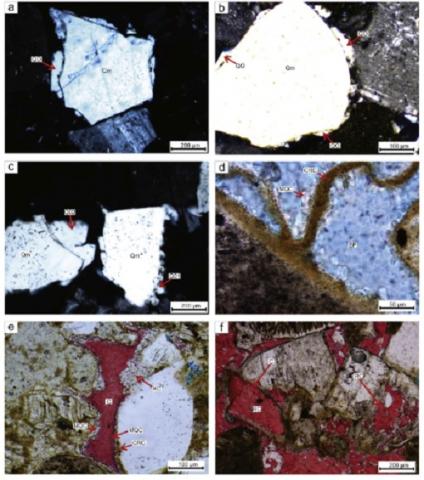Carlos Oscar Limarino, Sergio Roberto Giordano, Rodrigo Javier Rodriguez Albertani
2 017
Marine and Petroleum Geology Volume 88, December 2017, Pages 907-931
This paper analyses the diagenetic evolution of sandstones belonging to the Bajo Barreal Formation (Cretaceous) in the Golfo de San Jorge Basin (Patagonia, Argentina). The Bajo Barreal Formation includes the main reservoirs, which are located along the western area of the basin and is composed of sandstones, conglomerates, mudstones, tuffaceous mudstones and some layers of tuffs. The principal reservoirs comprise medium-to coarse-grained sandstones, which are dominated by feldspathic litharenites and contain minor amounts of litharenites and lithic arkoses. The authigenic minerals include kaolinite, smectite, chlorite, quartz overgrowths, microquartz and calcite, with minor proportions of megaquartz, siderite, analcime, laumontite, feldspar overgrowths and illite/smectite and chlorite/smectite mixed layers. Secondary porosity is much more important than primary porosity and is produced by the dissolution of feldspar, lithic clasts and clay cements. The diagenetic history of the Bajo Barreal sandstones can be divided into seven diagenetic stages, each of which is characterized by a specific assemblage of authigenic minerals and diagenetic processes. Eogenetic conditions occur in stages 1, 2, 3 and 4. Stage 1 corresponds to shallow burial characterized by the physical reduction of primary porosity by compaction; during stage 2, rim clay cements of chlorite, smectite and clinoptilolite, as well as thin quartz overgrowths, were formed. The precipitation of pore-filling cements of kaolinite, chlorite and smectite occurred during stage 3, while stage 4 records the intense dissolution of feldspar, lithic fragments and kaolinite cements. Mesogenesis occurs in diagenetic stages 5 and 6. The former corresponds to a new phase of authigenic kaolinite, while the latter records the significant dissolution of feldspar, lithic clasts and previous cements, which produced the highest values of secondary porosity. Finally, stage 7 corresponds to the highest degree of diagenesis in the Bajo Barreal Formation (mesogenesis), which resulted in the precipitation of cements of zeolites and calcite, as well as quartz and plagioclase overgrowths.

